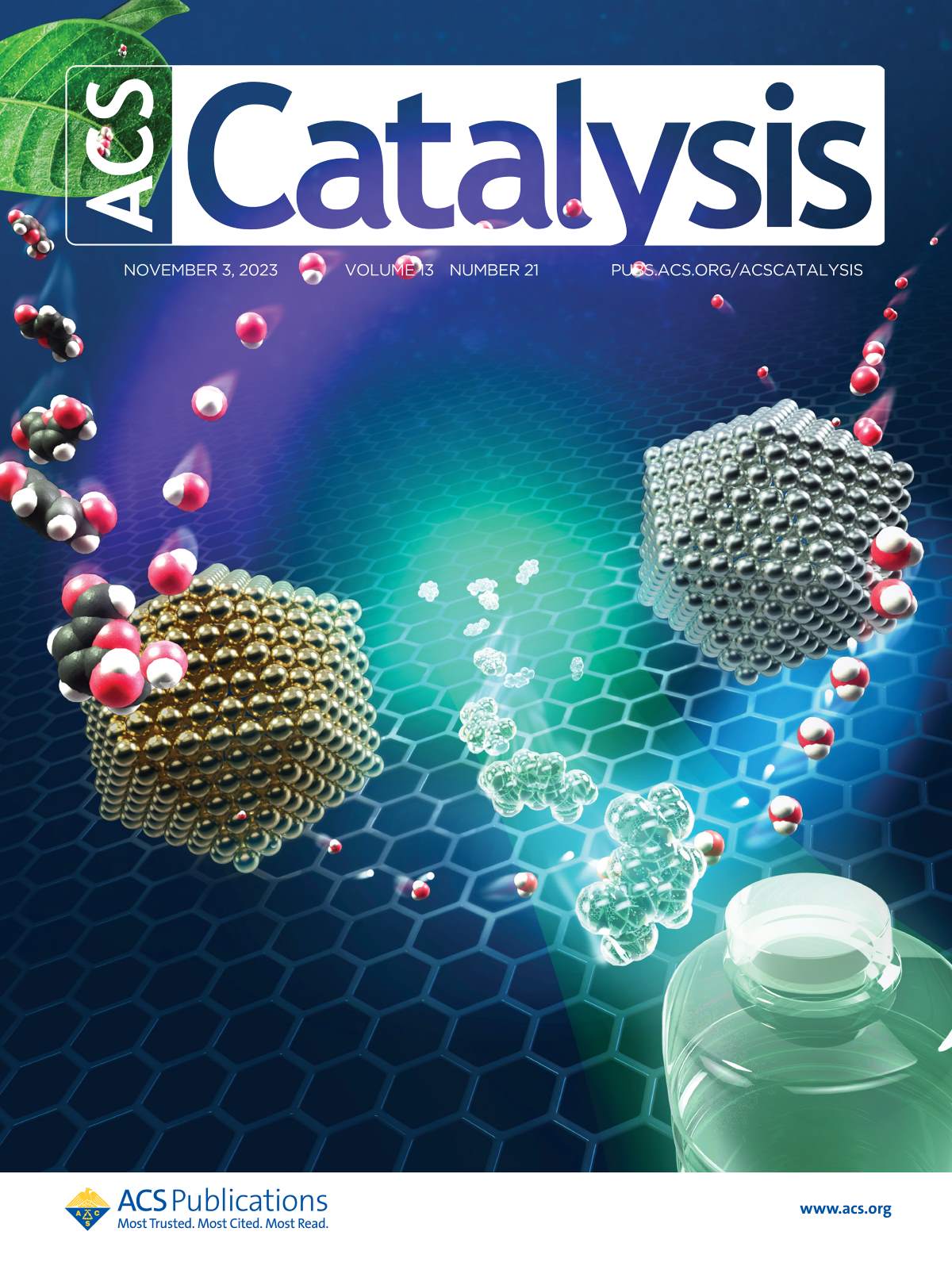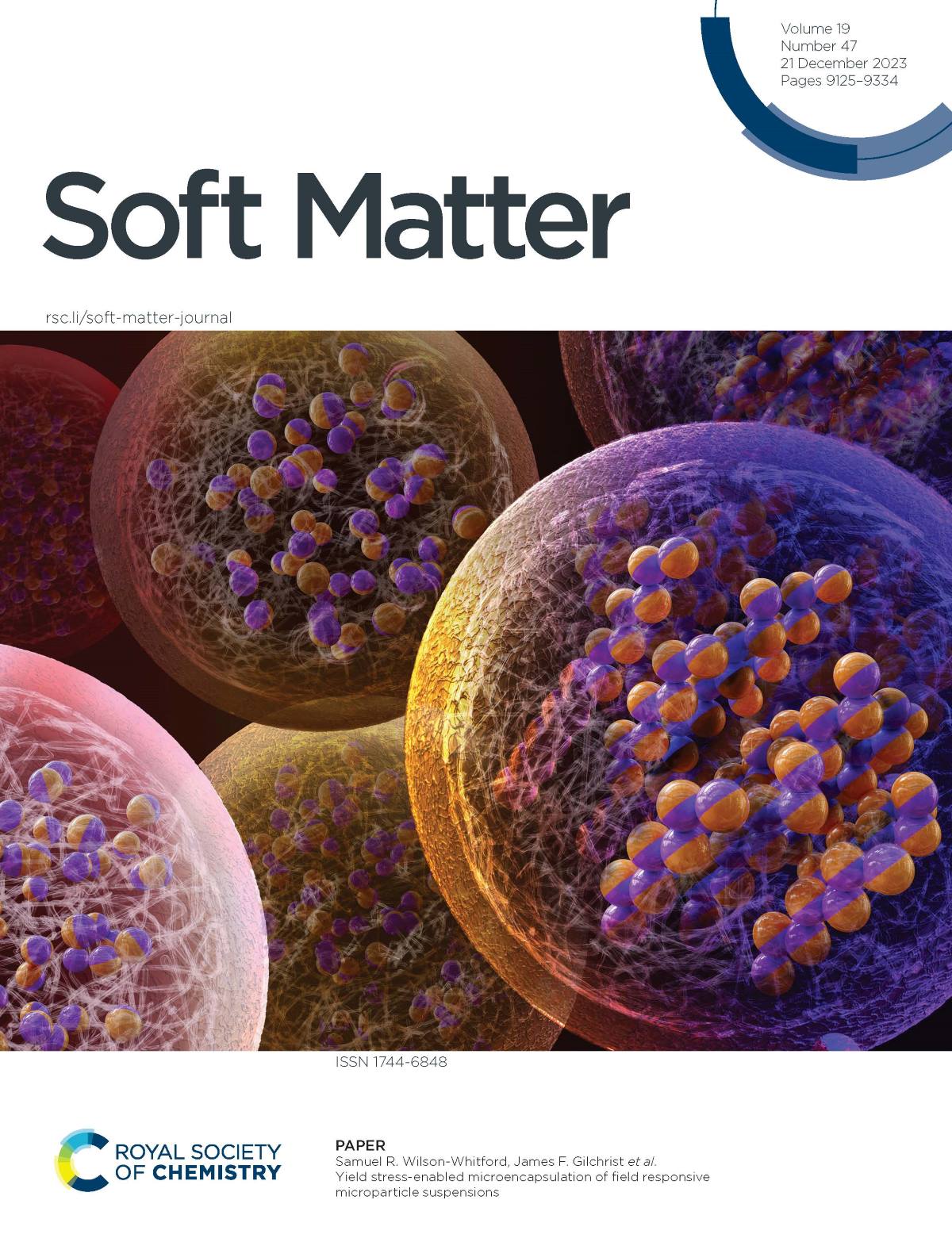Chemical and biomolecular engineering research has been front-page news several times this fall, with covers of recent issues of ACS Catalysis, Chemistry of Materials, and Soft Matter highlighting work by Lehigh ChBE teams.
 Working toward more efficient catalysts
Working toward more efficient catalysts
PhD student Bohyeon Kim, a member of the research group led by ChBE Chair Steven McIntosh, is co-lead author of the paper featured by ACS Catalysis (Nov. 3, 2023).
“In our study, we showed enhancement in production efficiency of 2,5-furandicarboxylic acid (FDCA) from hydroxymethylfurfural by using bimetallic catalysts,” says Kim. “FDCA is considered as a promising monomer for bioplastic polyethylene furanoate as a replacement of petroleum-based plastic polyethylene terephthalate, known as PET.”
Kim says the unique aspect of their study is the design of the bimetallic catalysts.
“Unlike the conventional bimetallic catalysts, we applied Cooperative Redox Enhancement (CORE), whereby physically separated dissimilar nanoparticles electrochemically couple to provide a significant enhancement in reaction rate. The CORE phenomenon was recently discovered through collaboration between the McIntosh and Kiely groups at Lehigh and the Hutchings group at Cardiff University, UK”
Their research, he says, addresses a common electrochemical phenomenon but poorly understood in thermocatalysis—electrochemical polarization in mixed thermocatalytic systems.
“By delving into the electrochemical coupling of catalytic sites and identifying the CORE effect, the study contributes to a deeper understanding of the mechanisms that drive catalytic reactions,” he says. “This understanding is essential for designing more efficient catalysts, which have widespread applications in various industries, including energy and environmental sectors.”
 Expanding the ‘toolbox’ for bioelectronics
Expanding the ‘toolbox’ for bioelectronics
The Chemistry of Materials cover (Nov. 14, 2023) illustrates the work of lead author Zeyuan Sun, a PhD student in the research group led by Professor Elsa Reichmanis, and his team.
“Our research studied a distinctive class of polymers, known as organic mixed ionic-electronic conductors (OMIECs), that could efficiently conduct electronic charges and transport ions simultaneously,” says Sun.
He says these materials show promise in the growing field of bioelectronics—particularly in the development of organic electrochemical transistors (OECTs).
“This work presented a novel strategy to introduce a series of carboxylic acid functionalized polymers as a path toward robust options in OMIECs,” says Sun.
Ultimately, by unraveling the fundamental structure-property relationship associated with the complex interplay of ionic-electronic coupling, polymer properties, and device performance, Sun and his team have expanded what he calls, the “synthetic toolbox.”
“The growing field of bioelectronics, where electronics meets biology, could lead to the creation of innovative medical devices for treatment and diagnosis,” he says.
 An advance for ‘e-ink’ displays
An advance for ‘e-ink’ displays
Samuel Wilson-Whitford, a former postdoctoral researcher in the lab led by professor James Gilchrist, is lead author of the study featured on the cover of Soft Matter (Dec. 21, 2023). Wilson-Whitford is now an assistant professor in engineering at the University of Warwick (UK).
“This fundamental research asked, ‘Can you make little capsules of particles so that when the magnetic field changes, the amount of light going through the capsule also changes?’” says Gilchrist, the Ruth H. and Sam Madrid professor of chemical and biomolecular engineering.
The problem is relevant to what’s known as “E-ink,” or electronic ink, which is technology used in e-readers (for example, the Amazon Kindle) that mimics the look of conventional ink on paper.
“E-ink displays can often be slow to refresh and they have electrodes on the top and bottom that make them somewhat delicate,” says Gilchrist. “We wanted to know if we could create magnetically responsive systems without electrodes that change how much light goes through the material, allowing a device to refresh faster and be more impact resistant.”
Wilson-Whitford led the team in the design of a novel microencapsulation process they coined “the soup dumpling process.” Nanoparticles called Janus particles half-coated in iron oxide to make them magnetic were placed within a gel inside a capsule. The gel was then emulsified into the oil phase, which limited the particles’ tendency to move and stick to the droplet interface.
Limiting that movement presented a “Goldilocks problem.” They had to make the gel strong enough that the particles couldn’t move to the walls of the capsule, but weak enough that when they applied a magnetic field, the particles could find each other through the gel, stick to each other, and make the chains that can then rotate their orientation.
“And we were able to do that,” he says. “We designed the fluid on the inside to have these non-Newtonian properties that would hold the particles in place well enough while we form the capsules, but then allow them to rotate when we added enough magnetic force, which changed the amount of light going through them.”
Highlighting impactful research
Gilchrist says the artist rendering of that result captured the process well.
“Having your research on a journal cover is always a big deal,” he says, “but in this case, it really advertises the beauty of science.”
Graduate students Kim and Sun say seeing their work displayed on a cover for the first time was especially meaningful.
“It meant that the journal editor considered our work to be one of the most impactful papers in the issue,” says Kim. “And that really reflects positively on the quality of research that we’re doing here at Lehigh.”
Sun agrees. “It’s proof of Lehigh’s dedication to high-quality research and innovation,” he says. “And for me personally, developing ideas and concepts for a cover design was an invaluable experience that allowed me to think creatively. Because a visually striking cover has the power to attract a broader audience—outside of academia—and can help engage and inform the general public.”
